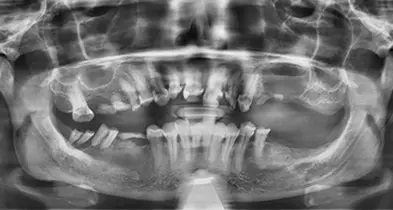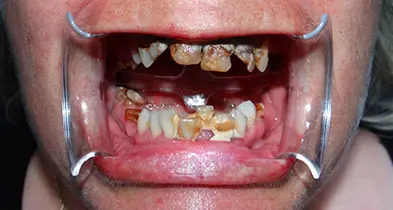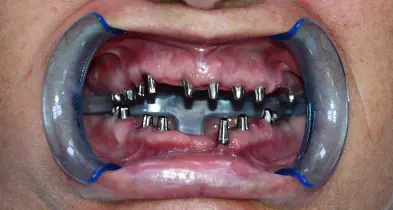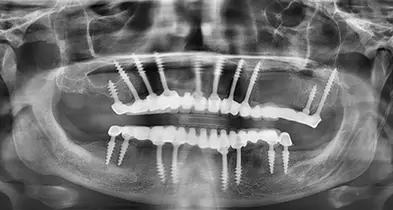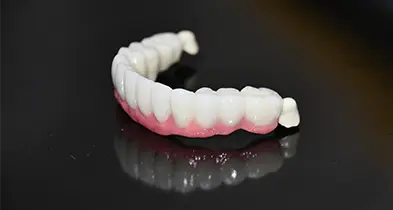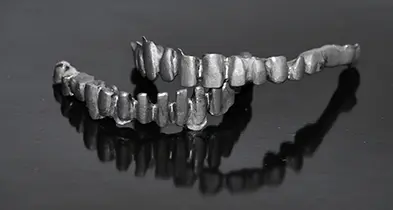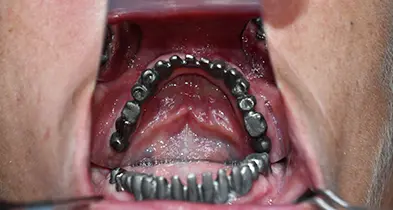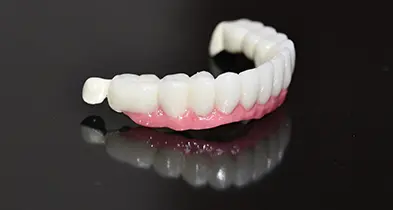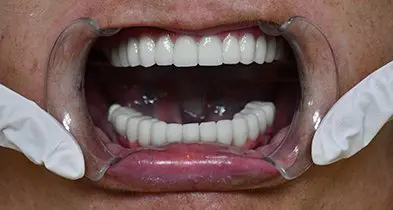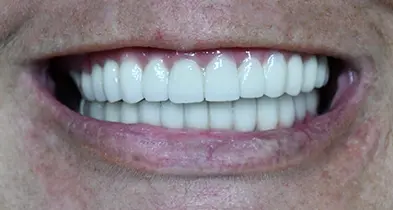BASAL IMPLANT
Basal dental implants are a revolutionary and completely new method of dental rehabilitation that does not require bone replacement even in the worst cases. They are made of a biocompatible titanium alloy. They are one-piece implants (implant and abutment are monolithically connected).
What is basal implantology?
Bone consists of an inner soft (spongy) part that is covered with a dense bone layer (cortical). Each basal implant is placed in at least two places in the cortical bone(bi-cortical). The cortical bone that is used to place basal implants is highly mineralized and with a high degree of regeneration. This ensures the integration of dental implants and allows their immediate loading. They differ from classical (two-part) implants in the way they are placed, in the way of redistribution of forces, but especially in the planning and implementation of the prosthetic structure and the postoperative regime.
What is basal implantology?
Features:
Features:
- Basal dental implants are the first choice in moderate or severe atrophy of the jaws, as well as in cases where patients want an immediate return to chewing function.
- Basal implants are suitable for placement even in cases of severe bone atrophy, that is, in patients with “insufficient” bone.
- There is no need for bone displacement (bone augmentation) and sinus lift before implant placement.
- Basal implants are placed in one visit by a less traumatic method than the traditional (two-part) implants.
- Primary load – on the third day after implantation, the prosthetic construction is cemented.
Features:
- Placing is appropriate in the absence of one or more teeth, even in the cases of totally edentulous patients (lacking teeth completely)
- Single crowns can also be placed on single basal implants. They load immediately only in certain situations.
- Possible complications of implantation are minimal. Because the placement is associated with less invasive surgical intervention, implants will place in the deep layers of the bone. This reduces the risk of infection several times compared to the classical (two-part) implants.
- There is no risk of peri-implantitis and other infections because the implants are made of polished titanium, and there is no plaque accumulation on the surface, creating inflammation.
- Severe and hopeless periodontal conditions can be treated with basal implants in one visit. After the removal of periodontal compromised soft tissues and teeth, the patient is ready for implant placement.
- Basal implants are a good choice for smokers and diabetics. Implant care includes perfect oral hygiene and regular prophylactic examinations.
Steps for immediate loading of the basal implants:
First day:
On the first visit, X-ray (OPG) or computed tomography (3D scan) will be performed, analyzed, and a treatment plan will be prepared, discussed with the patient.
• The patient and the dental practitioner will sign informed consent with the detailed treatment plan.
• The patient will consult with a cardiologist or anesthesiologist and if necessary, they will prescribe premedication (correction of blood pressure, pulse, blood sugar, allergies, antibiotic).
• Photo preparation before the procedure; preparation of the oral cavity for the intervention.
• The implants selected are tailored to the specifics of the patient.
• Intervention will conduct under local dental anaesthesia.
• The teeth will be extracted according to the treatment plan, immediately implants will place and will check up X-rays.
• After inserting the implants, they will do plastic surgery on the soft and hard tissue around the implants. This achieves an equal foundation on which the future metal-ceramic structure will lie.
• The dentist will take impressions for the dental laboratory.
Second Day
On the second day, the metal skeleton of the future construction will fabricate. On this day, the patient can approve the shape, size, and length of the teeth, and gain an insight into their future vision. The color of the construction will be selected, and the metal skeleton will be sent back to the dental laboratory.
Third Day
On the third day, the ceramic part of the prosthetic construction will fabricate. On this day, the patient can see his new smile, with his approval and the dentist’s regarding the color, shape, and size – the prosthetic construction will cement constantly.
The execution time of one jaw – three days
Temporary or permanent constructions? Which option should I choose?
At the Nurident Dental Clinic, we want our patients to be as well informed as possible about every intervention and manipulation so that we can make the best decision for each case together.
The only disadvantage of immediate implantation is that in the case of multiple tooth extractions (removal of several teeth) a gap can form between the gum and the constructions. This is a completely normal physiological process and although the distance is only a few millimetres, it can cause discomfort to the patient – food debris can accumulate, and this can result in unsatisfactory aesthetics. For patients who are about to undergo multiple extractions, we recommend choosing the option of placing temporary teeth. Two visits to Sofia and the Nurident Dental Clinic are necessary for a complete transformation of the smile. During your first visit to Sofia, you must visit us for three consecutive days. During this time, we perform all manipulations described in the option “New smile in 3 days”. The only difference is that for 2-3 months, you will wear temporary constructions and not permanent ones. During this time, the soft and hard tissues will recover completely, minimizing the risk of future discomfort. When the patients wear temporary constructions, they can also easily decide whether or not they are satisfied with the height of the bite. The temporary teeth also serve as a guide for smile design. After 3 months, the patient comes back to the Nurident Dental Clinic. The temporary teeth will be removed, additional dental implants will also be placed if necessary, we will take impressions, and a control orthopantomogram will be performed. Besides, we will take intraoral and extraoral images, and then the smile design will start. This will gives you a detailed idea of your future smile, allowing you to choose the shape, size, length, and colour of your teeth. We will send the taken impressions to the dental laboratory, and within a week, the finished permanent constructions, will be cemented onto the dental implants, and you can go home.


